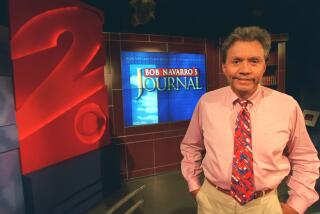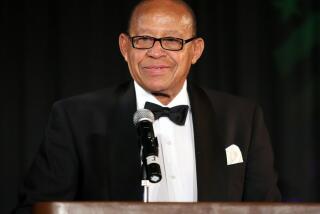America’s eyes and ears on the fields of war
WASHINGTON -- Charles Collingwood was broadcasting on live radio from Normandy, one of the correspondents assigned to cover World War II for the famed CBS broadcaster Edward R. Murrow. U.S. troops were landing on Omaha Beach, and Collingwood had 15 minutes of live air time.
His view blocked, his chatter running out, Collingwood -- according to journalist Dan Schorr -- turned to a man in uniform. Thrusting a live microphone in his face, the CBS correspondent asked him how things were going in the D-Day operation. “How would I know, Charles?” the man replied. “I’m with NBC.”
War has often made celebrities of correspondents and the soldiers they covered. William Howard Russell’s dispatches from the Crimean War for the Times of London made him famous -- and enshrined the British soldiers making the charge of the light brigade. Richard Harding Davis of the New York Journal helped William Randolph Hearst romanticize the cause of the Spanish-American War.
But the generation of reporters most remembered for bringing home the realities of war are those who covered World War II. Modeling their coverage after Ernie Pyle, the nice-guy correspondent who spent his time with the troops, they roved the battlefield in search of a good story.
Now, watching televised pictures of U.S. tanks rolling through the sand-swept Iraqi desert, of bombed-out buildings and downed helicopters, the generation that might be called the Original Embeds is reminiscing. About the grunts they used to cover. About the technological wonders that make today’s footage a marvel of 24/7 immediacy. About war.
“I can’t tear myself away,” said Walter Cronkite, who covered World War II in the Pacific and in Europe for United Press and, after the war, the Nuremberg trials. Asked if he is envious, he replied, “You bet.”
Cronkite, now 82, tore his Achilles tendon two years ago and feels the injury would slow him on the battlefield. “I couldn’t keep up or I’d be there now,” said the former anchor of the CBS Evening News, who retired in 1981. “And if not there, I’d like to be on an anchor desk somewhere.”
“If I were 40 years younger, I would be there,” said Max Desfor, photographer who covered World War II and Korea, and earned the Pulitzer Prize for his 1951 photo of Korean refugees fleeing along the twisted girders of a bombed bridge. Now 89 and living in Leisure World in Silver Spring, Md., Desfor reminisced about the two-day lag time for photographic film transported from Korea to Tokyo for processing. “Now you have a photographer who shoots a picture, sits down wherever he is, takes out a chip, puts it in a gizmo, shoots it into the sky, and voila,” he said. “And the quality is wonderful.”
The Original Embeds, accredited to Supreme Headquarters Allied Forces in Europe, wore military uniforms. The only tip to their profession was the green-and-gold patch on a left pocket or shoulder that said “war correspondent.” They were not “embedded” for the long haul but roved from battle to battle, returning to a press tent at night or after a few days, to file by telegraph or radio. Their copy had to be cleared by a censor, who usually stamped his approval as long as reporters did not disclose the name or location of the unit they were with, or hint at planned operations. There was no television.
Cronkite said he was “lucky to be chosen for some pretty good assignments.” He escorted freighters through a nest of U-boats. Made the landing on North Africa. Covered the air war against France and Germany from London, flying with the 8th and 9th Air Forces. Was with the 3rd Army when the Battle of the Bulge began.
“We were accredited as correspondents but not embedded,” he said. “If we really wanted to go to a battle, we simply showed up on the doorstop. The briefing officer would tell us where action would be that day. If we wanted to attend, we picked up a jeep and went. We might stay two or three days, we might live in a foxhole or in a nearby farmhouse or go back to the base to file our stories.”
Andy Rooney, the curmudgeonly commentator on CBS’ “60 Minutes,” was a World War II correspondent for the Stars and Stripes, which he said had a robust wartime circulation of 2 million. “I had my own jeep because I was an Army sergeant,” he boasted.
Watching televised images of war now, Rooney said he is “surprised how much I know about war. I really saw it close for a long time.” On television, he added, “it looks like some game you got at the toy store.”
Richard C. Hottelet, 85, is the last of the “Murrow Boys,” the 11 proteges of Murrow who pioneered the use of radio, and later television, for news. A correspondent for UP in Berlin, he survived four months in a Nazi prison in 1941. Later, after a stint in the U.S. Office of War Information in Washington and London, CBS hired him to cover the European theater.
He would go forward with troops and circle back to file. In the fall of 1944, the allied radio broadcasters used a press camp in Spa, Belgium, that he remembers well. “There was a press wireless office, with a microphone in a rudimentary studio for radio broadcasting,” he said. “It was a little room in a nondescript building, with blankets around the wall so you wouldn’t sound hollow.”
Filing conditions were primitive and undependable. “It was a radio circuit,” he said. “The notion of getting to New York in two minutes on a satellite phone was inconceivable to us.” The radio circuit was “a sometimes thing, because we often had sun spots or interference,” said Hottelet, who remembers that “more often than not, you turned up at a wireless studio with a script and were not able to hear New York. So I would just start in blind, in the hope they were hearing me. It often worked, astonishingly enough.”
Toward the end of the war, he said, “when were moving fast, to meet the Russians on the Elbe River, I didn’t have access to a transmitter so I’d send people back with typed copy to cable to New York.” Mostly, said Hottelet, “you just decided where to go to find a story. You talked to people and everybody was free to talk to you.”
It is unlikely that any correspondent in World War II talked to more servicemen than Ernie Pyle, whose dispatches of ordinary soldiers doing their jobs remain so vivid that his colleagues are still talking about him. He was famous for making war personal. “Ernie Pyle reported the GIs and they loved him,” said Hottelet. “They were very glad to see reporters, especially at the very front. They were totally cut off from normal life. Then somebody comes along and tells their story, asks their hometown.”
Rooney said Pyle, who was killed by a Japanese sniper in 1945 on an island off Okinawa, sometimes got his stories by staying on the back lines when other reporters went forward. “Most of us were going to the front but Ernie tended to go back,” he said. “I remember one piece where he found a company that was sorting through the effects of soldiers killed. They would separate their stuff, launder the uniforms and send them back for reissuing. It made a great piece.”
Clarence Wyatt, a historian at Centre College in Kentucky, estimates that at the height of World War II, there were some 1,600 journalists roving the battlefields in Europe and Asia. Their journey was eased by Gen. Dwight D. Eisenhower.
In an order issued to all unit commanders of the allied expeditionary force a few weeks before D-Day, Eisenhower insisted the press be given “the greatest possible latitude in the gathering of news.” Hottelet has kept a copy of the order, which he digs out to read to a reporter in that sonorous radio voice that kept listeners on the edge of their seats during the war. “They should be allowed to talk freely,” he read, “with officers and enlisted personnel and to see the machinery of war in operation in order to visualize and transmit to the public the conditions under which the men from their countries are waging war against the enemy.”
John Steinbeck and other famous writers dropped by the battlefield from time to time, but Pyle “gave the foxhole view of World War II, and that is what the embedded journalists are doing now,” said Douglas Brinkley, a historian at the University of New Orleans. “At the time of his death, Pyle was in 400 daily newspapers and an endless number of weeklies. The impact was formidable in getting the feel of battle. Today’s Scud studs may not have the same reportorial skills but they are showing the same courage and ability in a real-time war.”
It was slice-of-life stuff. It was hero worship. And it made celebrities of the journalists.
Pyle was mobbed when he returned home in September 1944. The Murrow Boys became the hottest force in radio, along with names like H.V. Kaltenborn and William Shirer (who later wrote “The Rise and Fall of the Third Reich”). Some made the leap into the television era. Cronkite left the UP for CBS Television and went on to become the most trusted name in broadcasting -- Uncle Walter, people called him -- the man who informed a generation that John F. Kennedy had been assassinated, that a man had landed on the moon, that Vietnam had become a quagmire. In February 1968, one month after the Tet Offensive, Cronkite concluded a special report by saying, “It seems now more certain than ever that the bloody experience of Vietnam is to end in a stalemate.” President Johnson commented, “If I’ve lost Walter Cronkite, I’ve lost Mr. Average Citizen.”
Cronkite’s support was not the only casualty of Vietnam. Some 58,000 Americans died in combat, many drafted into action. And the war soured relations between the military and the media for a generation. With a virtual free run at the battlefield, reporters saw a guerrilla warfare not reflected in the military briefings in Saigon, which they dubbed “The Five O’Clock Follies.”
The current Pentagon policy of embedding reporters with the troops represents something of a healing of the breach. It’s true, said Rooney, that “a guy’s not going to write a lot of negative stories about guys you eat breakfast with.”
Nostalgia runs deep among the veteran correspondents and the glut of images from Iraq provoke memories of Europe and Asia. “It put me back some years, particularly in watching the Marines and the 3rd Army division advances and some of the British,” said Desfor. “I was with the Marines a great deal in World War II and particularly in Korea, and in Korea I was with the 3rd when it captured Pyongyang.”
Desfor, who prefers the photograph to the televised image -- “Maybe I’m prejudiced, but the stills are better” -- finds that even the soldiers look familiar.
“One remarkable difference is the tremendous amount of clothing and gear these guys wear,” he said. “I don’t know how they can slog through the hills in utter heat. How they’re doing it with all this gear in sandstorms, I can’t imagine.”
More to Read
Sign up for Essential California
The most important California stories and recommendations in your inbox every morning.
You may occasionally receive promotional content from the Los Angeles Times.










